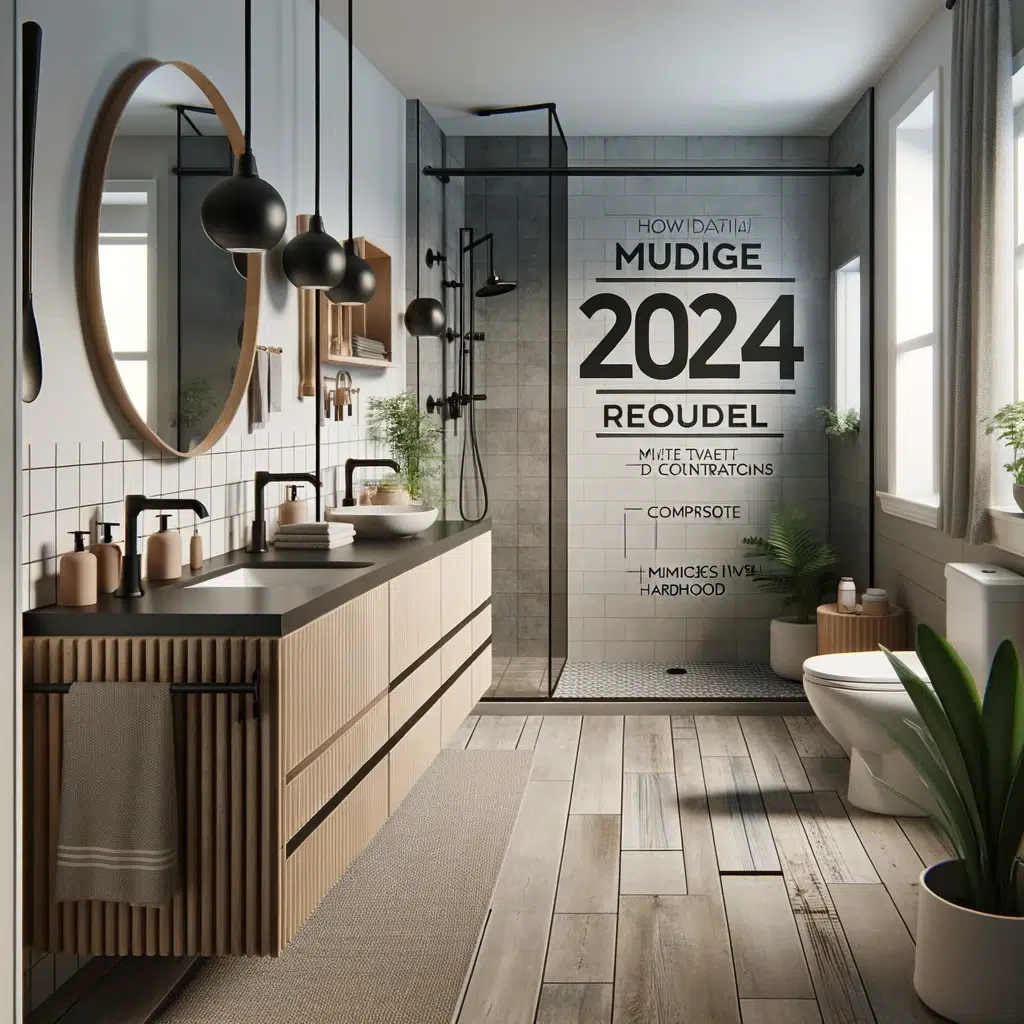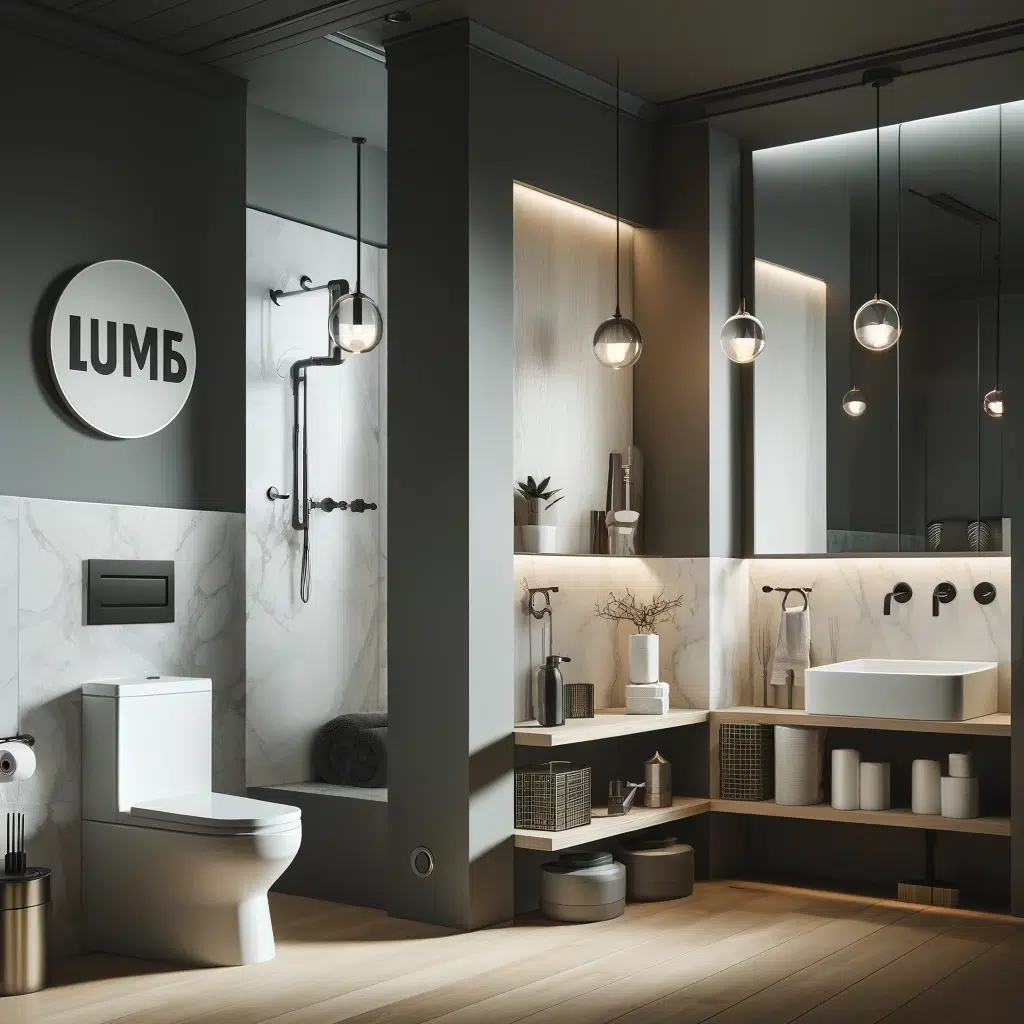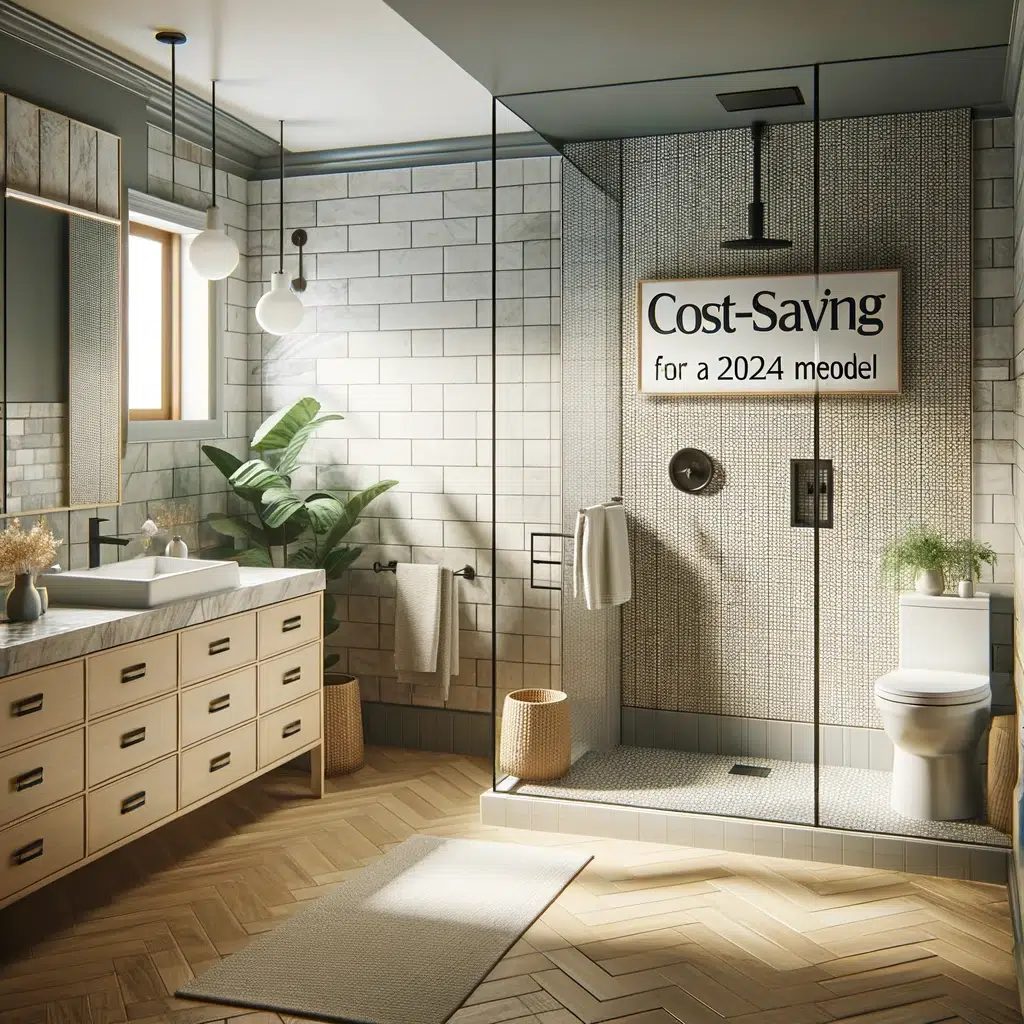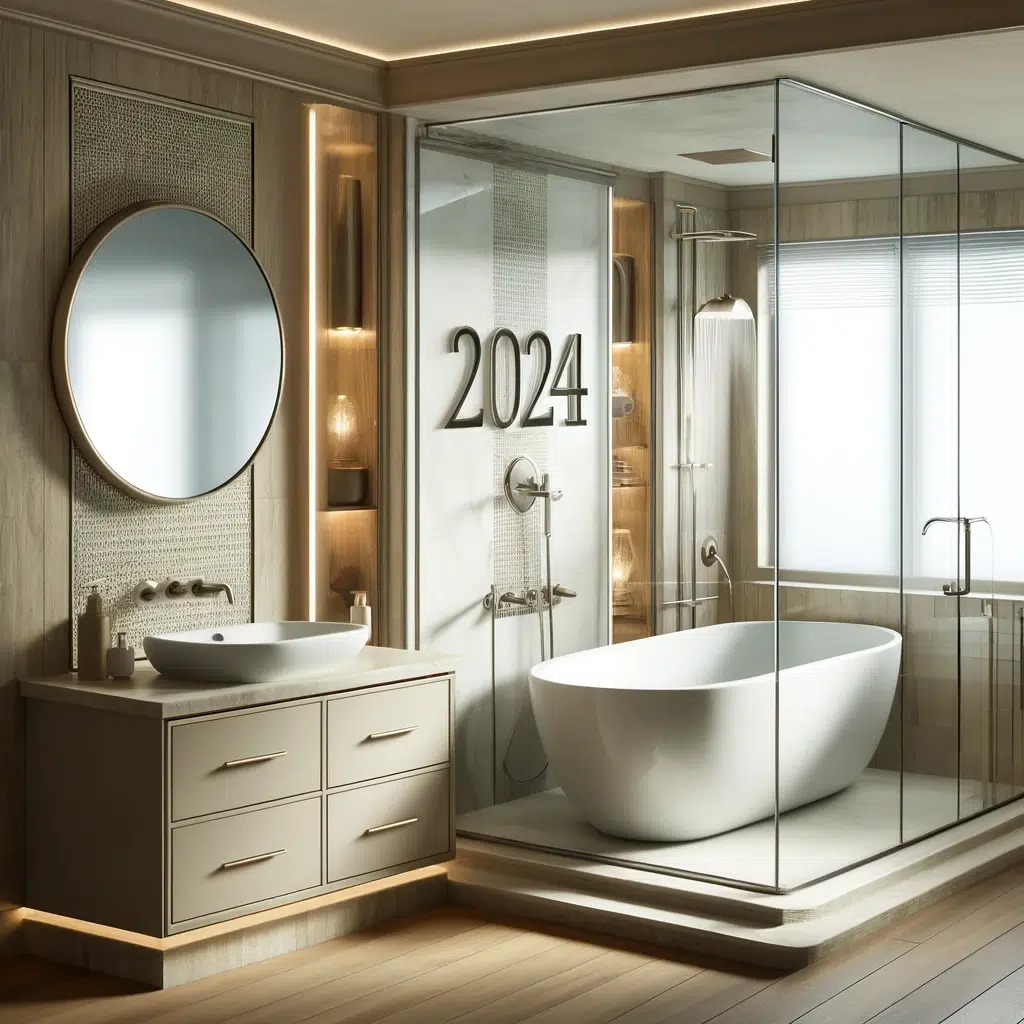Bathroom Remodeling Cost in 2024
Are you considering a bathroom remodel in 2024 but unsure about how much it might set you back? Understanding the costs of updating your bathroom is crucial for setting a realistic budget and making informed decisions.
As we move into 2024, various factors from labor rates to material costs are evolving, and staying informed can help you navigate these changes effectively.
Whether planning a minor update or a complete overhaul, knowing what financial commitment you’re looking at is the first step toward a successful remodel.
The bathroom remodeling cost in 2024 can vary widely based on the scope of your project and the quality of materials you choose. For a basic update—like replacing fixtures and repainting—you might spend only a few thousand dollars.
However, if you’re considering more extensive changes, such as rearranging the layout or installing high-end finishes, the costs could climb much higher.
It’s important to factor in everything from the tiles to the taps, as well as whether you’ll need professional help for certain aspects of the job.
Understanding these costs upfront will help you prioritize your desires against your budget, ensuring you get the most out of your remodel without unexpected financial strains.
Understanding Bathroom Remodeling Costs in 2024
Curious about the average cost breakdown for a bathroom remodel in 2024? Whether you’re planning a minor refresh or a major renovation, knowing how your budget will be distributed among the various aspects of the project can help you plan more effectively.
Generally, the largest portion of the budget goes towards labor, which can account for up to 50% of the total cost, depending on the complexity and scale of the project.
Next in line are fixtures and finishes, including sinks, showers, and tiling, which typically consume about 15-20% of your budget.
What about the rest of the expenses? Well, cabinetry and hardware can take another 10-15%, while plumbing and electrical work might account for an additional 10%.
Don’t forget to set aside some funds for unexpected issues or upgrades that often arise during remodeling projects.
It’s also wise to factor in the cost of design services if you’re planning to hire a professional designer.
By understanding this cost structure, you can prioritize your spending and make decisions that align with both your budget and your bathroom’s needs, ensuring you get the most out of your remodel investment.
Average Cost Breakdown for a Bathroom Remodel
When it comes to remodeling a bathroom in 2024, understanding the average cost breakdown is essential for effective budgeting and planning.
Typically, a comprehensive bathroom remodel can range from a few thousand dollars for basic upgrades to tens of thousands for high-end renovations.
The largest expense in most bathroom remodels is labor costs, which can account for about 40% to 60% of the total budget, depending on the complexity of the work and the rates in your region.
This includes fees for plumbers, electricians, carpenters, and any other required specialists.
Next, materials play a significant role in shaping the budget. High-quality fixtures like sinks, bathtubs, and toilets can consume about 15-20% of your budget.
Flooring and wall materials, such as tiles, typically take another 10-15%. Additional expenses like vanities, lighting, and paint will contribute to the costs, each varying by the quality and style chosen.
Don’t overlook the need for a contingency budget, ideally 10-20% of the total cost, to cover unexpected expenses that frequently arise during remodeling projects.
Planning with these figures in mind helps ensure that you can achieve your desired outcome without unwanted financial surprises.
How Material Choices Affect Your Bathroom Remodel Cost
Material choices play a pivotal role in determining both the cost and the character of your bathroom remodel. Opting for high-end materials such as marble or granite for countertops and designer tiles for flooring can significantly increase the overall cost.
These materials are not only expensive to purchase but may also require special installation and maintenance, adding to the overall expense.
Conversely, choosing more budget-friendly options like laminate countertops and ceramic tiles can help keep your costs down while still providing durability and style.
Furthermore, the choice of fixtures such as taps, showers, and bathtubs can also affect your budget dramatically.
High-quality fixtures with advanced features like water-saving technologies or integrated digital controls tend to come with a higher price tag but can offer long-term savings in water usage and enhanced comfort.
It’s important to balance aesthetic preferences with practical considerations, considering not only the initial cost but also the long-term implications of your material choices, such as durability and maintenance requirements.
By carefully selecting materials that align with your budget and bathroom design goals, you can manage costs effectively while creating a space that feels both luxurious and functional.

Free Guide: Bathroom Remodeling Cost 2024
Labor Costs: What to Expect When Remodeling Your Bathroom
Labor costs are a significant component of any bathroom remodel and can vary widely based on several factors.
Typically, these costs can make up anywhere from 40% to 60% of the total project budget, depending on the complexity of the work and the professionals involved.
Understanding what to expect in terms of labor costs is crucial for setting a realistic budget for your renovation.
Firstly, the extent of the remodeling plays a crucial role in determining labor costs.
If you’re planning a simple cosmetic update, such as replacing fixtures and painting, labor costs will be relatively lower.
However, more extensive renovations that involve moving plumbing, structural changes, or installing high-end fixtures will require skilled labor from plumbers, electricians, and carpenters, driving up the cost.
Additionally, the geographical location of your property can impact labor rates; urban areas tend to have higher labor costs compared to rural areas.
Always get multiple quotes from contractors to ensure you get the best deal and check their references to ensure quality work.
By understanding these aspects, you can better manage the financial aspect of your bathroom renovation, ensuring that labor costs do not exceed your expectations or your budget.
Cost-Efficient Bathroom Remodeling Tips for 2024
Achieving a cost-efficient bathroom remodel in 2024 doesn’t necessarily mean sacrificing quality or style. With strategic planning and smart choices, you can renovate your bathroom beautifully while keeping expenses in check. Here are some practical tips to help you save money without compromising on your vision:
- 1. Plan Thoroughly Before Starting:
One of the most effective ways to save money is to plan every detail of your remodel before beginning. Changing plans mid-project can lead to wasted materials and additional labor costs. A detailed plan helps you avoid unexpected expenses and ensures that you stay within budget.
- 2. Reuse Where Possible:
Consider which components of your existing bathroom can be reused or refreshed rather than replaced. For instance, refinishing your current bathtub or re-grouting tile can significantly reduce costs compared to buying new. Even updating fixtures like faucets and drawer handles can give your bathroom a new look without a major investment.
- 3. Choose Cost-Effective Materials:
Opt for materials that offer durability and style without a high price tag. For example, porcelain tiles mimic the look of natural stone but are much more affordable and easier to maintain. Composite or laminate countertops are another excellent option that provides aesthetic appeal at a lower cost than natural stone.
- 4. Do Some of the Work Yourself:
If you have the skills, taking on some of the work yourself can reduce labor costs significantly. Simple tasks like painting, installing hardware, or even tiling are within reach for many DIY enthusiasts. However, be sure to leave plumbing and electrical work to the professionals to avoid costly mistakes.
- 5. Shop Around for Supplies and Contractors:
Get quotes from multiple contractors to ensure you’re getting the best price for the work. Additionally, shop around for fixtures and materials. Check out sales, discount outlets, and online retailers to find the best deals.
- 6. Keep the Existing Layout:
Changing the layout of your bathroom can lead to significant plumbing and electrical costs. If possible, keep the existing layout and focus on updating the fixtures and finishes instead.
By incorporating these strategies, you can manage your bathroom remodeling project more efficiently, keeping costs down while still achieving a fresh, new look for your space in 2024.
The Impact of Size and Layout on Bathroom Remodeling Costs
The size and layout of your bathroom are critical factors that can significantly impact the overall cost of your remodeling project. Understanding how these elements affect your budget can help you make more informed decisions during the planning process.
- Size of the Bathroom:
The larger the bathroom, the more materials and labor will be required, naturally increasing the cost. Flooring, wall coverings, and the amount of tile needed will scale with the size of the space.
Additionally, larger bathrooms may accommodate more luxurious fixtures and amenities, such as double vanities, separate showers and bathtubs, or even additional features like a bidet, all of which can add to the expense.
Conversely, smaller bathrooms may limit your options but can be less costly due to the reduced need for materials and potentially simpler designs.
- Layout of the Bathroom:
The complexity of your bathroom’s layout also plays a significant role in determining bathroom remodeling costs. A straightforward layout with minimal structural changes will generally be less expensive to remodel.
Significant layout changes, such as moving plumbing fixtures or tearing down walls, can increase costs dramatically. These modifications often require professional help from plumbers, electricians, and perhaps even architects, which can add to the labor costs significantly. Sticking to the existing layout or making only minor modifications can help keep costs more manageable.
By considering the size and layout implications early in the planning process, you can set a more accurate budget and explore design options that optimize both functionality and cost-efficiency.
This proactive approach allows you to balance your desires for a dream bathroom with the practical aspects of renovation expenses.

Free Guide: Bathroom Remodeling Cost 2024
Comparing DIY vs. Professional Bathroom Remodel Costs
When deciding between a DIY or professional approach to remodeling your bathroom, understanding the potential cost implications of each option is crucial. Each path offers unique advantages and challenges, and the choice can significantly affect your overall budget.
-
DIY Bathroom Remodel Costs:
Embarking on a DIY bathroom remodel can offer substantial savings, primarily by eliminating labor costs. If you have a solid set of skills in areas such as tiling, plumbing, or carpentry, you can significantly reduce the expenses associated with your project.
Additionally, DIY projects allow you to shop around for materials, potentially finding deals and discounts that a professional might not utilize. However, it’s important to consider the potential hidden costs.
Mistakes can be costly, especially with tasks that require expert knowledge like electrical wiring or plumbing. The need for specialized tools might also add to your expenses, and projects can take longer to complete if you are working in your spare time.
- Professional Bathroom Remodel Costs:
Hiring professionals for your bathroom remodel often means a higher initial investment, particularly in terms of labor costs. However, professionals bring efficiency, expertise, and a higher level of craftsmanship to the project.
They can complete the job faster and with fewer mistakes, which can be a cost-saving in itself by avoiding costly errors and redo work.
Additionally, many contractors get materials at a wholesale rate, and their experience allows them to anticipate problems and manage complex changes, such as altering your bathroom’s layout or installing advanced fixtures.
Importantly, the work of licensed professionals typically comes with warranties and adheres to the latest building codes, adding security to your investment.
Ultimately, the choice between DIY and hiring professionals should be based on a careful evaluation of your skills, the complexity of the remodel, and your budget constraints.
If the project is extensive or involves significant structural, plumbing, or electrical changes, the assurance of quality and safety that comes with professional work might justify the extra cost.
For simpler updates, a DIY approach could be a rewarding and cost-effective option.
Latest Trends in Bathroom Design and Their Cost Implications
Staying on top of the latest trends in bathroom design not only keeps your space modern and stylish but can also have significant implications for your remodeling budget. As 2024 approaches, several key trends are emerging that can influence both the aesthetic and the cost of your bathroom renovation.
-
1. Sustainable and Eco-Friendly Materials:
There’s a growing trend towards using sustainable and environmentally friendly materials in bathroom designs, such as recycled glass tiles, bamboo flooring, and countertops made from reclaimed materials.
While choosing eco-friendly materials can sometimes be more expensive upfront, they often lead to savings in the long run through greater durability and efficiency. Additionally, these materials can increase the property’s value due to their appeal to environmentally conscious buyers.
-
2. Smart Bathroom Technologies:
The integration of technology in bathroom appliances and fixtures is another trend gaining momentum. Smart showers, touchless faucets, and heated floors offer enhanced comfort and convenience, while smart toilets with self-cleaning features, night lights, and automatic lids provide luxury and hygiene.
However, the inclusion of high-tech gadgets can significantly increase the overall cost of a remodel due to the expensive nature of these technologies and the additional installation work they may require.
- 3. Bold Colors and Textures:
Moving away from the classic whites and grays, bold colors and rich textures are making their way into bathroom designs. Terrazzo flooring, colorful vanities, and textured walls can make a strong visual impact but might come with higher price tags for materials and maintenance.
-
4. Open and Spacious Layouts:
There is a continuing trend towards more open and airy bathroom layouts, often involving changes to the room’s physical structure, such as removing walls or expanding into unused spaces.
These alterations can dramatically increase the cost of remodeling due to the need for structural, plumbing, and electrical modifications.
Each of these trends offers a unique blend of aesthetics and functionality, but it’s crucial to consider their long-term implications on your budget and lifestyle.
Incorporating these trends thoughtfully into your design can ensure that your bathroom not only looks cutting-edge but also adds value and efficiency to your home.
Financing Your Bathroom Remodel: Options and Advice
Financing a bathroom remodel can seem daunting, but various options are available to help manage the financial aspect of your renovation project. Choosing the right financing strategy can make the difference between a stressful endeavor and a smoothly executed update to your home.
-
1. Home Equity Loans and HELOCs:
One of the most popular ways to finance a bathroom remodel is through home equity loans or Home Equity Lines of Credit (HELOCs). These options are secured against the equity of your home and typically offer lower interest rates compared to other financing methods.
Home equity loans provide a lump sum upfront, which is ideal for covering the total cost of a remodel at once.
In contrast, HELOCs offer a line of credit that you can draw from as needed, making them suitable for projects where expenses may be spread out over time.
- 2. Personal Loans:
If you prefer not to use your home as collateral, personal loans are an alternative. These loans are based on creditworthiness rather than home equity, and they can be obtained quickly from banks, credit unions, or online lenders.
The interest rates might be higher than those of home equity loans, but there’s no risk of losing your home if you face repayment issues.
-
3. Credit Cards:
For smaller remodels or if you expect to repay the debt quickly, credit cards can be a convenient option, especially those offering 0% APR promotions.
This method allows you to finance your project interest-free if you can pay off the balance before the promotional period ends. However, high-interest rates after the promotional period can make this an expensive option if the balance isn’t cleared in time.
-
4. Government Loans:
Certain government programs can help finance home improvements. For example, Title 1 Property Improvement Loans and FHA 203(k) loans offer funds for those who meet specific eligibility requirements, often with favorable terms.
-
5. Cash-Out Refinancing:
Another approach is cash-out refinancing, where you refinance your mortgage for more than you owe and take the difference in cash.
This can be a good option if mortgage rates have dropped since you took out your original loan, as it might allow you to fund your remodel without significantly increasing your monthly payments.
Before choosing a financing option, consider factors such as the total cost of the loan, repayment terms, and how the monthly payments will fit into your budget.
It’s also wise to consult with a financial advisor to ensure that the chosen method aligns with your financial situation and goals. By carefully planning your finance strategy, you can ensure your bathroom remodel moves forward without financial hitches.

Budget Planning: How to Save on Your Bathroom Remodel in 2024
Effective budget planning is essential for saving on your bathroom remodel in 2024. With the right strategies, you can keep costs under control while achieving the look and functionality you desire.
Here are practical tips to help you plan your budget and find savings during your bathroom renovation:
-
1. Define Your Priorities:
Start by identifying what’s most important to you in the remodel. Are you looking for aesthetic updates, or are functionality and layout more critical?
Prioritizing your needs helps allocate your budget to the most impactful changes, ensuring you spend money on aspects that add the most value to your bathroom.
- 2. Shop Around for Materials and Fixtures:
Don’t settle for the first price you see. Take the time to shop around and compare prices from different suppliers and retailers.
Consider alternative materials that offer a similar look and feel at a lower cost.
For example, instead of natural stone tiles, you might opt for ceramic tiles that mimic the stone at a fraction of the price. Additionally, look out for sales and discounts, especially during major holiday weekends or end-of-season clearance events.
-
3. Do Some of the Work Yourself:
If you have the skills, consider taking on some of the remodeling tasks yourself. Simple tasks like painting, installing hardware, or even laying tiles can be done without professional help.
However, it’s important to be realistic about your skills and the time you can dedicate to these tasks. For complex plumbing or electrical work, it’s safer and potentially more cost-effective in the long run to hire professionals.
-
4. Keep the Existing Layout:
Changing the layout of your bathroom often means moving plumbing and electrical points, which can significantly increase labor and material costs. If possible, keep your toilet, sink, and bath in their current positions to save on these costs.
-
5. Opt for a Partial Remodel:
Instead of a full renovation, consider a partial remodel. Focus on updating key elements like the vanity, faucets, or lighting fixtures. These smaller changes can refresh the space without the need for a complete overhaul.
-
6. Plan for Unexpected Costs:
Always include a contingency in your budget for unexpected expenses. Typically, setting aside an additional 10-20% of your total estimated budget can help cover unexpected costs without causing financial stress.
By meticulously planning and considering these strategies, you can save money while still creating a beautiful and functional bathroom that meets your needs in 2024.

